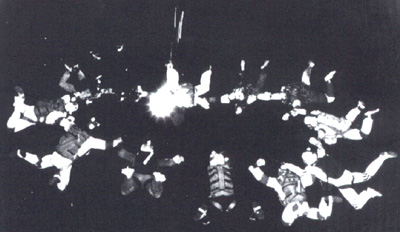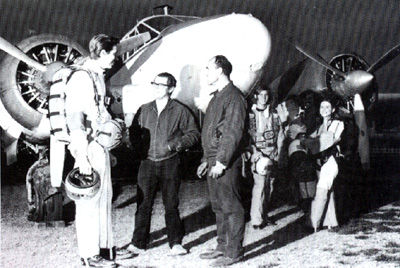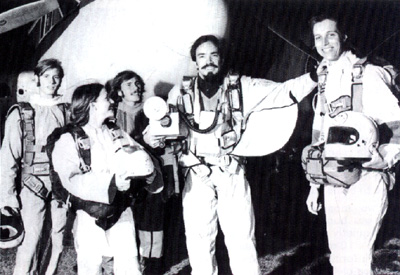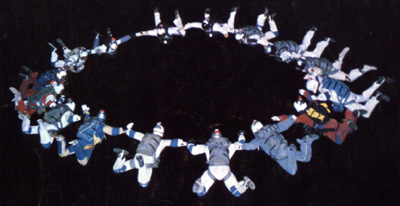Featured Exhibits
Sign up for the Newsletter
Advertise on ParachuteHistory.com
Disclaimer
Privacy Policy
About
Journey to a 16-way Night World Record
The Elsinore Flying Farkle team of the early 70's was a closely-knit group that pushed the envelope of RW. They gathered weekend after weekend to build larger and larger formations. They spent a lot of time and energy to achieve success.Besides practicing for 10-way competitions, they tried many difficult and outlandish formations. Most of the dives worked as planned.
They had a crazy idea of doing a night 9-way star. They did that and the Star Crest Awards were expanded to the Night Star Crest. Three days later another group made a night 8-way. The competition had begun.
John Donovan and Steve Fielding organized the first night 10-way star in February 1972. Donovan could not make the jump because his Air Force duties transferred him away from Elsinore.
There were many concerns about doing night RW. Safety was of utmost importance. Jumper experience was another concern. Fielding established two rules to enhance the success of night dives.
- Flashing strobes were forbidden.
- Large formation attempts should be done as close to a full moon as possible.
These rules came about from an earlier 5-way no contact dive that had someone with a strobe. The dive was very disorientating. Fielding said "The main problem offering the highest potential for failure or injury is lack of depth perception. To set up on a flash of white light and 2 or 3 seconds later find it has moved 50 to 100 feet horizontally just doesn't get it. This disorientation led me to design my own continuous red light and make it available to the other jumpers on the load. Full moon jumping gives us some ground reference, which would prove invaluable in the event of disorientation, especially after break-off. And it adds some visibility in freefall."
With these rules and lighting in place, the record 10-way night dive went off without a hitch. Of course, the extra tension on the load was noticeable, but the flying was very similar to daytime, just a bit slower and more conservative. Fielding reported, "The actual night RW experience we had prior to the 10-way was minimal. A few of us had made 3 or 4 ways, but no one person in the group stood out with a strong background in night RW."
The rewards were shared among the jumpers on the load. There was no photography of night dives then. There were no crowds on the ground that could see them.
Copycats out in Florida did a 10-way night star less than a week later.
The bar had been raised. Fielding was committed to doing a night 16-way. Two months later the Fielding load did an 11-way night star. Shortly afterwards, M. Anderson Jenkins went about solving the problem of photographing a night dive.
The load capacity of a single Beech aircraft had been reached. The next dives were formation loads. This posed an ever-higher RW experience requirement upon the participants.
"Once the lighting problem was taken care of, we directed our energy to discovering if there were any basic freefall requirements that differed from our day work. I suspected, and we later learned, that from the number five man back, we would have problems closing on the base because of the limitation imposed by the lack of depth perception. I urged the group to always set up to one side of the base, fly down TO it, then ACROSS and into a slot. The 'mush' does not readily lend itself to our type of night RW. This approach solved 90 percent of our flying difficulties. Try it; you'll like it" - Steve Fielding
Most of the jumpers on the load had 600 to 700 jumps. They never funneled any of the attempts, but they were concerned about what to do in case they did. Should they reform, stay in the general area or pull immediately? Everyone was concerned about collisions.
Fielding made an 'in-case of funnel' rule: BREAK OFF IMMEDIATELY, REGARDLESS OF ALTITUDE, AND TRACK AWAY OBSERVANTLY TO OPENING ALTITUDE.
The next record was a 12-way night star. The formation aircraft were a Beech and a Cessna 180. It built smoothly and rapidly. Jenkins had a flash synchronized with his camera. Each time he took a photograph, the formation lit up. Bud Krueger fired a 20-second flare when the star was complete. The group broke off at 4000 feet.

Night 12-way Record with Bud Krueger holding a flare.
A few more lessons were learned on this successful 12-way night star. Black or dark jumpsuits did not photograph well at night and were hard for others to see. A new rule of having a jumpsuit at least 50% white was added. The photos were amazing to everyone. Jumpers came in from the jet-black sky to dock. There was a ball of fire in Bud Krueger's hand after lighting the flare.
There was no clamoring to get on the next load even after the great news and photos became widespread. Fielding stated "We didn't expect our project to set the jumping world ablaze; the deeper we got into it, the more we realized night RW is definitely not everyone's thing. And we felt we still had a long way to go before we could speak with any degree of authority on the subject."
The dives grew slowly. A 14-way night star was built in July 1972 with 15 on the load. Another 14-way was built with 16 people on the load. Pressure of the dives was beginning to show. Perhaps, the 16-way was too elusive.
in the order Purple Patti gave them to Geronimo
- Bud Krueger
- Al Krueger (NSCR#11)
- Bob Westover
- Dennis Trepanier (NSCR#13)
- Warren Frazier
- Steve Fielding (NSCR#15)
- Chuck Wickliffe (NSCR#17)
- Ron Haun (NSCR #16)
- Jerry Kinley
- Alan Babich
- "Purple Patty" Wickliffe (NSCR#19)
- Jim Handbury
- Jack Miles
- Rich Piccirilli
- Bill Boles (NSCR #6)
- Lynn Fogleman
February 17, 1973 was the date for the 16-way night star. Gary Douris flew the lead Beech and Gus Norberg flew the trail Beech. Tension on board was noticeably high. The jumpers got the cut, then exited. The Kruegers formed the base. White jumpsuits came from the inky blackness, paused, flew across to a slot and docked. Rich Piccirilli, Mr. 'Last one in, or not at all', hovered until all others were docked. He made his move and docked to complete the first ever 16-way night formation. The formation was built by 6000 feet. It took only 40 seconds for them to build it.

L to R: Steve Fielding, Gary Douris, Gus Norberg, Jim Handbury, Rich Piccirilli, Patti Wickliffe.

Steve, on far right, pioneering the use of full-face helmets.
L to R: Jim Handbury, Purple Patti, Rich Piccirilli, Mike Anderson Jenkins, Steve Fielding.
Fielding remarked "Most of the people who remained with the project to its completion agree that what they've accomplished is more personally rewarding than any jumps they've made to date. What we want to stress is that our accomplishment is meant as a guide, not as a challenge to anyone. Large night RW attempts are potentially very dangerous and only by never losing sight of that potential were we able to accomplish what we did. We certainly expect that others across the country will enjoy night RW as we do. Mike went up later in the night of the 16-way to film another NSCR attempt, and when his camera jammed, he broke into the star to earn his NSCR. You should have seen the look on his face when he got his card and the number was already up to 133! So that's a good indication to us that there are plenty of people getting might experience. We found that the key to good night RW is PEOPLE; techniques just aren't that different from day RW, only slower."
4/29/72 first Night 11-way (approx. 11:40pm).
5/28/72 first Night 12-way (at 12.05am).
7/22/72 first Night 14-way (10:30pm).
2/17/73 first Night 16-way (9:15pm).
This was truly an incredible time in the sport. There were many other "world records" being set at this same time with "largest star" formations, and "all-women" formations.
- Purple Patti
Photos by M. Anderson Jenkins.
[Products] | [Services]
[Join Our Mailing List] | [Advertise on ParachuteHistory.com]
[ ]
[Disclaimer] | [Privacy Policy] | [About]
